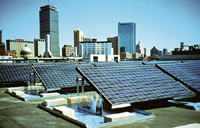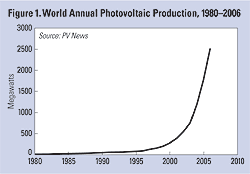Solar Power Set to Shine Brightly
|
 |
| Solar photovoltaic (PV) cells turn sunlight directly into carbon-free electricity. |
The solar industry is poised for a rapid decline in costs that will make it a mainstream power option in the next few years, according to a new assessment by the Worldwatch Institute in Washington, D.C., and the Prometheus Institute in Cambridge, Massachusetts.
Global production of solar photovoltaic (PV) cells, which turn sunlight directly into electricity, has risen sixfold since 2000 and grew 41 percent in 2006 alone. Although grid-connected solar capacity still provides less than 1 percent of the world's electricity, it increased nearly 50 percent in 2006, to 5,000 megawatts, propelled by booming markets in Germany and Japan. Spain is likely to join the big leagues in 2007, and the United States soon thereafter.
This growth, while dramatic, has been constrained by a shortage of manufacturing capacity for purified polysilicon, the same material that goes into semiconductor chips. But the situation will be reversed in the next two years as more than a dozen companies in Europe, China, Japan, and the United States bring on unprecedented levels of production capacity. In 2006, for the first time, more than half the world's polysilicon was used to produce solar PV cells. Combined with technology advances, the increase in polysilicon supply will bring costs down rapidly—by more than 40 percent in the next three years, according to Prometheus estimates.
Data |
 |
| Global production of solar photovoltaic (PV) cells has risen sixfold since 2000. |
“Solar energy is the world’s most plentiful energy resource, and the challenge has been tapping it cost-effectively and efficiently,” says Janet Sawin, a senior researcher at Worldwatch, who authored the update. “We are now seeing two major trends that will accelerate the growth of PV: the development of advanced technologies, and the emergence of China as a low-cost producer.”
The biggest surprise in 2006 was the dramatic growth in PV production in China. Last year, China passed the United States, which first developed modern solar cell technology at Bell Labs in New Jersey in the 1950s, to become the world’s third largest producer of the cells—trailing only Germany and Japan.
China’s leading PV manufacturer, Suntech Power, climbed from the world’s eighth largest producer in 2005 to fourth in 2006, and PVs have made the company’s CEO one of his nation’s wealthiest citizens. Experts believe that China, with its growing need for energy, large work force, and strong industrial base, could drive dramatic reductions in PV prices in the next few years, helping to make solar competitive with conventional power even without subsidies.
"To say that Chinese PV producers plan to expand production rapidly in the year ahead would be an understatement,” says Travis Bradford, president of the Prometheus Institute. “They have raised billions from international IPOs to build capacity and increase scale with the goal of driving down costs. Four Chinese IPOs are expected to come to market this month alone."
Resources |
In the meantime, supply shortages have led manufacturers to find ways to use polysilicon more efficiently, and have accelerated the introduction of new technologies that do not rely on purified silicon and are inherently less expensive to manufacture. So-called thin film cells can be made from amorphous silicon and other low-cost materials, and companies developing these technologies have recently become the darlings of Silicon Valley venture capitalists.
Although in the past, thin film cells have not been efficient enough to compete with conventional cells, today over a dozen companies—including Miasole, Nanosolar, and Ovonics—are competing to scale up production of low-cost solar modules that can be churned out like rolls of plastic.
"The conventional energy industry will be surprised by how quickly solar PV becomes mainstream—cheap enough to provide carbon-free electricity on rooftops, while also meeting the energy needs of hundreds of millions of poor people who currently lack electricity," Sawin says.
|
Worldwatch Institute - 1776
Massachusetts Avenue, NW, Washington, DC 20036 |